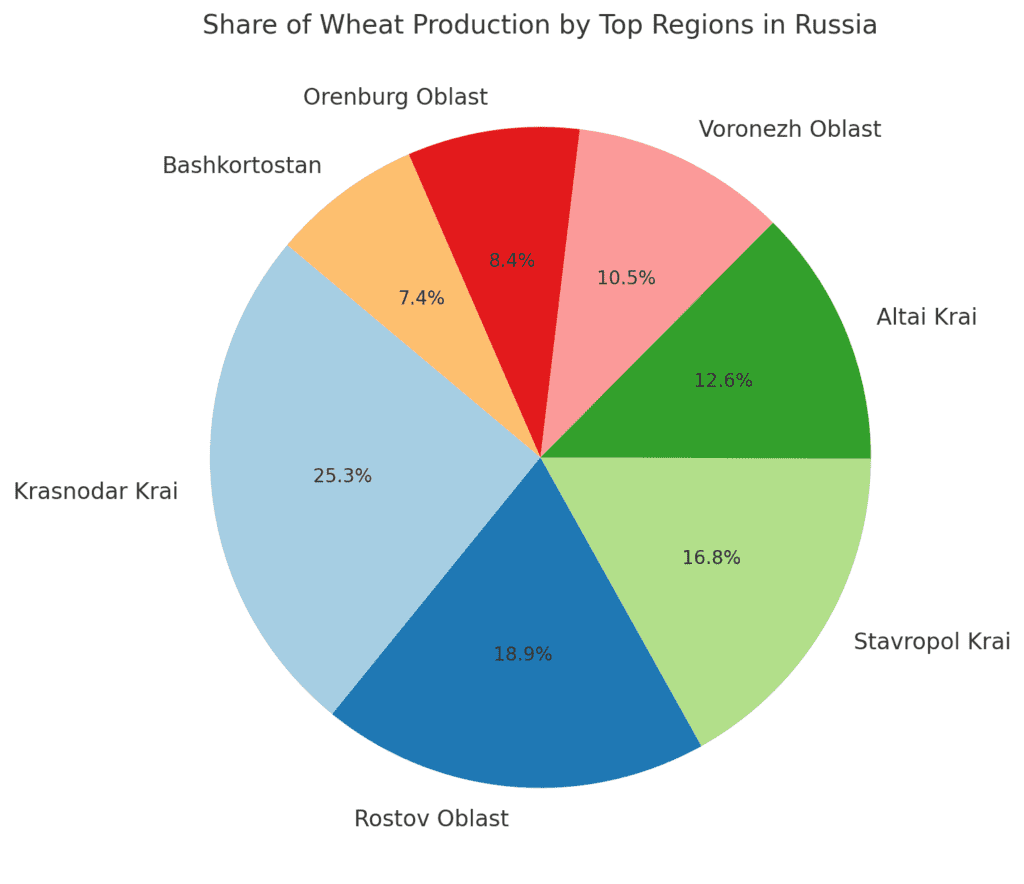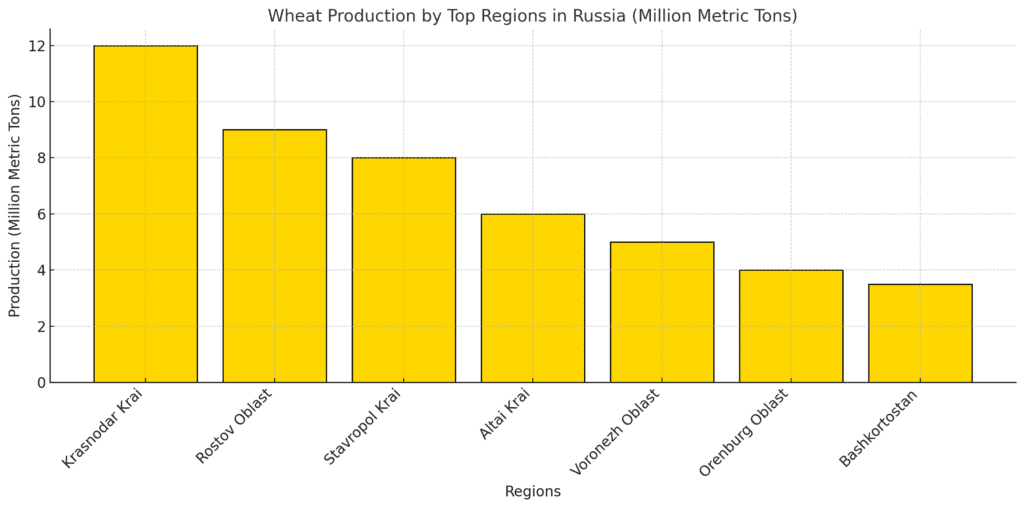Russia is one of the largest wheat producers globally, contributing significantly to the global wheat trade. Its vast agricultural lands and favorable climate make it a leading exporter, particularly to the Middle East, Asia, and Africa. This article explores Russia’s largest wheat-producing regions, their contributions, and the innovations shaping their agriculture sector.

1. Krasnodar Krai: The Wheat Capital of Russia
Krasnodar Krai is Russia’s top wheat-producing region, often referred to as the “breadbasket” of the country.
- Annual Production: Approximately 12 million metric tons.
- Key Characteristics: Fertile chernozem (black soil) and temperate climate.
- Innovations: Extensive use of mechanized farming and high-yield wheat varieties.
- Significance: Krasnodar Krai’s wheat is essential for both domestic consumption and export.
2. Rostov Oblast: A Major Contributor to Wheat Exports
Rostov Oblast is another key region for wheat production, strategically located near export ports.
- Annual Production: Around 9 million metric tons.
- Key Characteristics: Rich soils and access to the Don River for irrigation.
- Innovations: Implements precision agriculture and advanced storage facilities.
- Significance: A vital hub for Russia’s wheat exports to global markets.
3. Stavropol Krai: A Fertile Agricultural Region
Stavropol Krai is known for its productive farmlands and significant wheat output.
- Annual Production: Approximately 8 million metric tons.
- Key Characteristics: Fertile black soil and mild winters.
- Innovations: Use of hybrid wheat varieties and efficient pest management.
- Significance: Contributes substantially to Russia’s food security and exports.
4. Altai Krai: Wheat from the Heart of Siberia
Altai Krai is a prominent wheat-producing region in Siberia, leveraging its vast agricultural landscapes.
- Annual Production: Around 6 million metric tons.
- Key Characteristics: Favorable conditions for spring wheat cultivation.
- Innovations: Introduction of drought-resistant crops and sustainable farming practices.
- Significance: Supplies wheat for domestic use and neighboring regions.
5. Voronezh Oblast: An Emerging Agricultural Powerhouse
Voronezh Oblast is rapidly gaining prominence as a major wheat producer.
- Annual Production: Approximately 5 million metric tons.
- Key Characteristics: Fertile soil and expanding use of irrigation systems.
- Innovations: Focuses on organic farming and crop diversification.
- Significance: Supports Russia’s domestic grain market and processing industries.
6. Orenburg Oblast: A Leader in Spring Wheat Production
Orenburg Oblast specializes in spring wheat cultivation, making it a critical region for Russian agriculture.
- Annual Production: Around 4 million metric tons.
- Key Characteristics: Semi-arid climate suited for specific wheat varieties.
- Innovations: Use of water-saving technologies and precision farming tools.
- Significance: A key supplier to Russia’s domestic markets.
7. Bashkortostan: Wheat from the Volga Region
Bashkortostan contributes significantly to wheat production in the Volga region.
- Annual Production: Approximately 3.5 million metric tons.
- Key Characteristics: Diverse farming landscapes and government-backed support.
- Innovations: Utilization of modern harvesting equipment and integrated pest management.
- Significance: Supports regional food industries and exports.

Innovations Driving Wheat Production in Russia
Russia’s wheat-producing regions are leveraging various innovations to enhance productivity:
- High-Yield Varieties: Introduction of wheat strains resistant to pests and climate variations.
- Precision Agriculture: Use of GPS and satellite technology for efficient planting and harvesting.
- Sustainable Practices: Adoption of crop rotation and water conservation techniques.
- Storage Solutions: Development of modern grain silos and cold storage facilities.
Challenges Facing Russia’s Wheat Industry
Despite its strengths, Russia’s wheat industry faces notable challenges:
- Climate Variability: Unpredictable weather patterns affect yields.
- Logistical Issues: Long transport routes can increase costs for exports.
- Global Sanctions: Trade restrictions may impact international sales.
Conclusion
Russia’s largest wheat-producing regions, including Krasnodar, Rostov, and Stavropol, are critical to the nation’s agricultural success and global food supply. These regions combine favorable climates, fertile soils, and modern technologies to produce high-quality wheat for both domestic use and export. As global demand for wheat continues to rise, Russia’s wheat industry remains a key player on the world stage.



